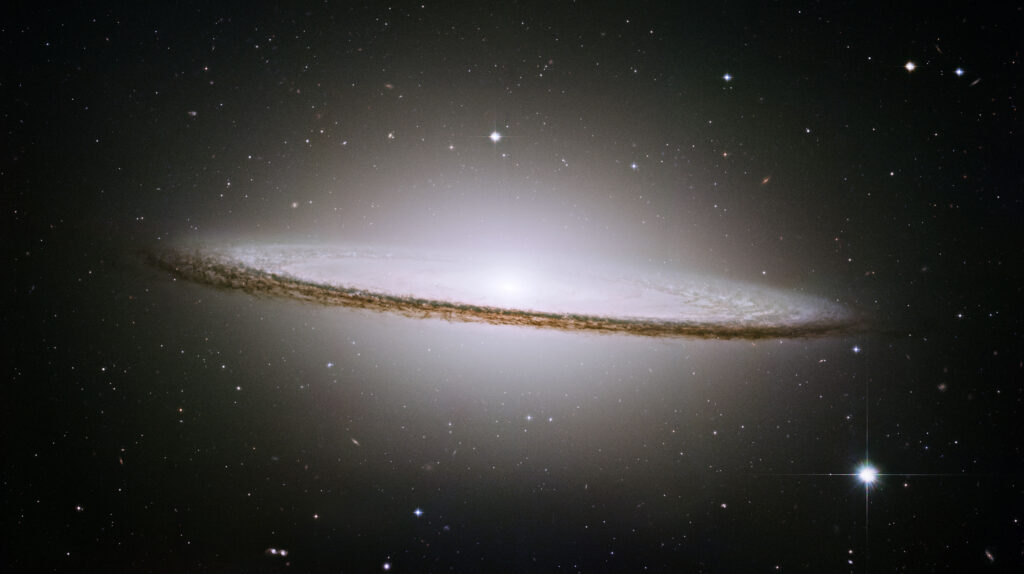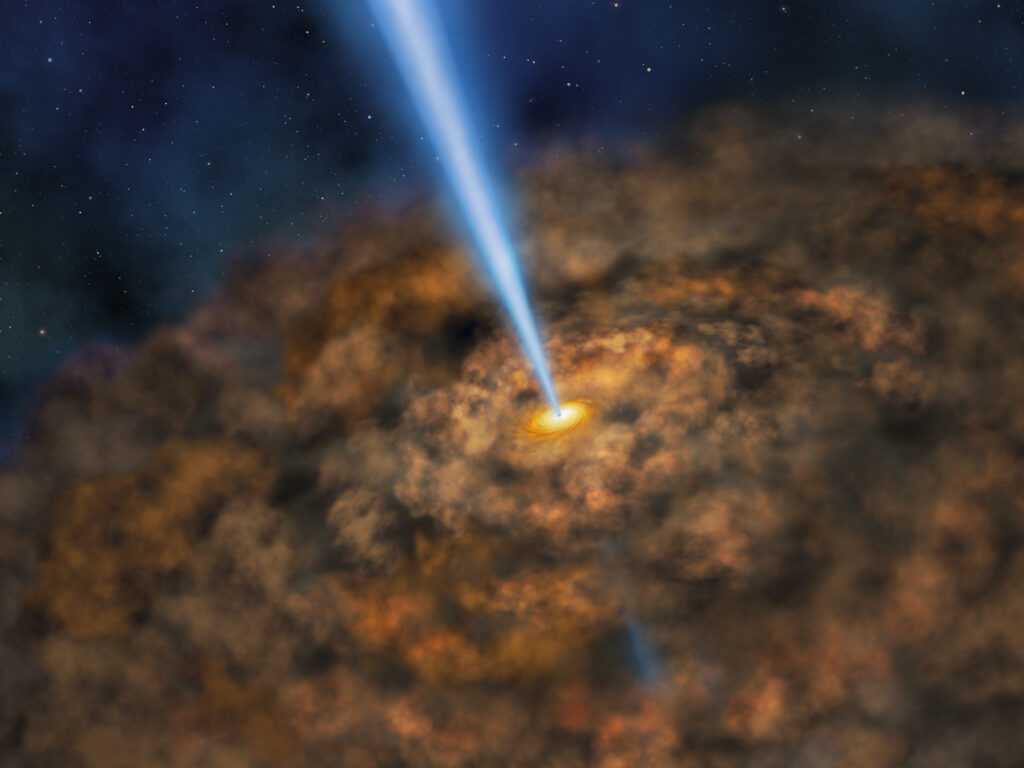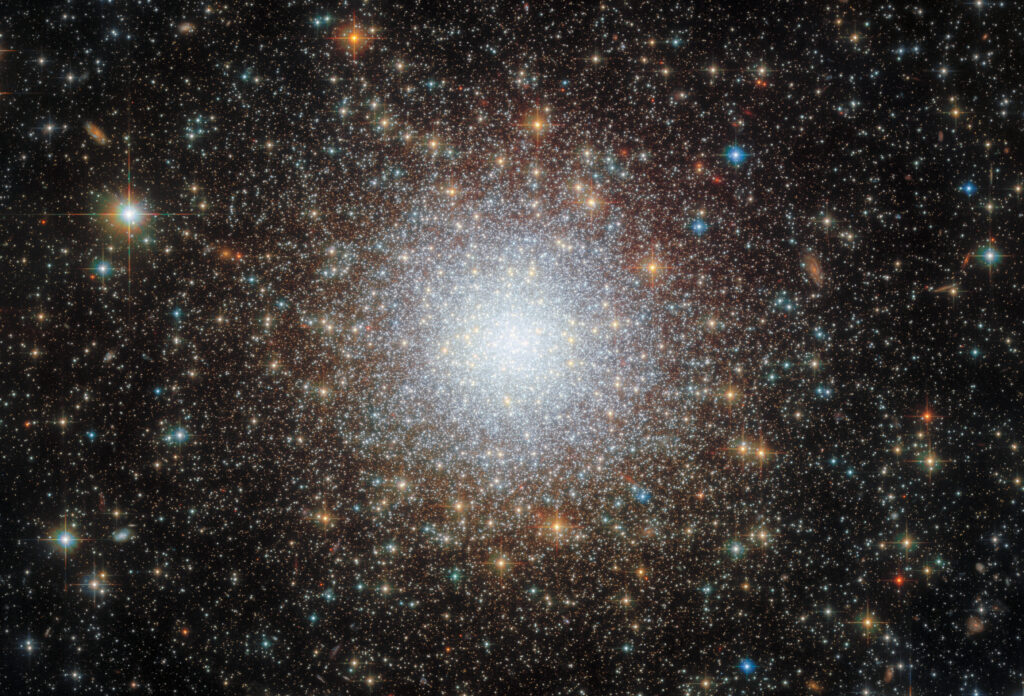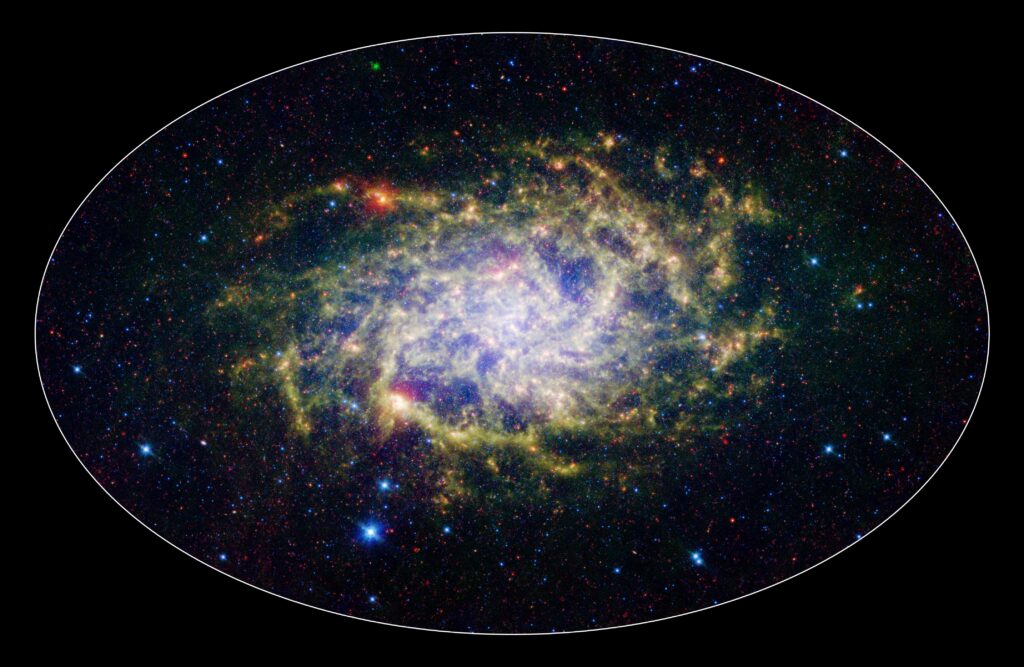A Cosmic Hat
© NASA
The Sombrero Galaxy, also known as Messier Object 104 (M104) or NGC 4594, is a peculiar galaxy located in the constellation borders of Virgo and Corvus, approximately 31.1 million light-years away from Earth, making it a distant yet observable object in the night sky. This galaxy is characterized by its unique appearance, resembling a sombrero hat due to its bright nucleus, large central bulge, and a prominent dust lane in its outer disk, which is viewed almost edge-on.
Situated amidst the Virgo II Groups, an arrangement of galaxies and galaxy clusters extending from the southern periphery of the Virgo Supercluster, its isophotal diameter spans roughly 29.09 to 32.32 kiloparsecs (94,900 to 105,000 light-years), rendering it slightly larger than our own Milky Way. Initially perceived as having a diminutive and light halo, suggestive of a spiral galaxy, observations from the Spitzer Space Telescope revealed the dust ring to be more substantial than previously conjectured, indicative of a colossal elliptical galaxy.
With an apparent magnitude of +8.0, the Sombrero Galaxy is readily discernible through amateur telescopes and is regarded by certain scholars as possessing the highest absolute magnitude within a radius of 10 megaparsecs from the Milky Way.
FORMATION OF SOMBRERO GALAXY

The formation of the Sombrero Galaxy, like that of many other galaxies, is a complex and ongoing process shaped by numerous factors. While the precise details of its formation remain a subject of ongoing research, astronomers have proposed several key mechanisms that likely contributed to its evolution:
- Gas Accretion: Early in its history, the Sombrero Galaxy would have begun as a protogalactic cloud of primordial gas and dust. Over time, gravitational forces would have caused this cloud to collapse, forming dense regions where stars could begin to coalesce.
- Galactic Mergers: Major mergers with smaller galaxies are thought to have played a significant role in the formation of the Sombrero Galaxy. These mergers would have triggered intense bursts of star formation and reshaped the galaxy’s structure, potentially contributing to the formation of its central bulge and halo.
- Disk Formation: As the Sombrero Galaxy evolved, the gravitational interaction between its stars and gas would have led to the formation of a rotating disk structure. Within this disk, spiral arms would have formed due to density waves propagating through the galactic disk, triggering the formation of new stars.
- Central Bulge Formation: The formation of the Sombrero Galaxy’s central bulge is likely linked to the accumulation of stars and gas towards its galactic center. Processes such as mergers and interactions with neighbouring galaxies would have contributed to the growth of the central bulge, leading to the formation of a dense, spherical region of stars.
- Feedback Processes: Throughout its evolution, the Sombrero Galaxy would have experienced feedback processes that regulated its star formation rate and gas content. Supernova explosions, stellar winds, and active galactic nuclei (AGN) would have injected energy into the interstellar medium, influencing the formation of new stars and the distribution of gas within the galaxy.
- Halo Formation: The halo of the Sombrero Galaxy likely formed through a combination of processes, including the accretion of satellite galaxies, the disruption of globular clusters, and the ejection of stars from the galactic disk through interactions with other galaxies. The halo plays a crucial role in the overall dynamics of the galaxy, influencing its gravitational interactions with neighbouring galaxies and contributing to the stability of its structure.
STRUCTURE

The defining feature of the Sombrero galaxy is its luminous white central bulge surrounded by dense dust lanes that form the spiral structure of the galaxy. When observed from Earth, the galaxy appears almost edge-on, tilted at an angle of just six degrees north of its equatorial plane.
CENTRAL BULGE
The Central Bulge of the Sombrero Galaxy is a distinctive feature at its core, characterized by its significant concentration of stars and luminosity. This galaxy’s central bulge is so densely packed with old stars that it has caused a noticeable bulge in one area, resembling the top of a hat, hence its name. The presence of this central bulge, along with the dust lane, gives the galaxy its sombrero-like shape when viewed from Earth. It is notably large compared to the bulges found in many other spiral galaxies.
- Composition: The central bulge of the Sombrero Galaxy comprises two main components: an inner bulge and an outer halo. This region consists primarily of older stars, which have likely formed earlier in the galaxy’s history. The stars within the bulge are typically older and redder than those found in the galaxy’s spiral arms.
- Gravitational Influence: The Central Bulge exerts a strong gravitational pull on surrounding stars, gas, and dust within the galaxy. The gravitational pull of this central bulge affects the motion of stars and other celestial objects within the galaxy, contributing to its overall stability and evolution.
- Supermassive Black Hole: During the 1990s, a team headed by John Kormendy provided evidence of a supermassive black hole residing within the Sombrero Galaxy. Utilizing spectroscopy data collected from both the CFHT and the Hubble Space Telescope, the team revealed that the stellar velocities at the galaxy’s core necessitated the presence of a mass equivalent to 1 billion solar masses to maintain them. This discovery marked one of the most massive black holes ever measured in a neighbouring galaxy and positioned it as the closest billion-solar-mass black hole to Earth.
DISK
The disk of the Sombrero Galaxy is a distinctive feature characterized by a bright, white, bulbous core surrounded by thick dust lanes that form the spiral structure of the galaxy. This dust lane is where star formation occurs within the galaxy. Recent observations have revealed that the Sombrero Galaxy’s disk contains an unexpected abundance of metal-rich stars typically found in a galaxy’s disk and central bulge, challenging conventional theories about galaxy makeup. The galaxy’s disk extends beyond its central portion, housing tens of thousands of individual stars and a rich system of globular clusters estimated to be nearly 2,000 in number.
Gas within the disk plays a crucial role in the formation and evolution of stars within the galaxy. It serves as the raw material from which stars are born and is influenced by various processes such as supernova explosions and interactions with neighboring galaxies. The disk rotates around its central bulge, with stars and gas orbiting the galactic center in a manner consistent with the laws of gravity. This rotation contributes to the overall stability and dynamics of the galaxy.
Despite its smooth appearance, it contains an intriguing mix of shapes found in both disk-shaped spiral galaxies and football-shaped elliptical galaxies, making it a unique hybrid galaxy. The disk of the galaxy is vast, with an apparent diameter of approximately 29.09 to 32.32 kiloparsecs (94,900 to 105,000 light-years), slightly larger than the Milky Way.
DUST LANE
The dust lane of the Sombrero Galaxy is a prominent feature that encircles the bulge of the galaxy, rich with gas, dust, and hydrogen gas, providing the necessary elements for star formation. This dust lane is a symmetrical ring that encloses the bulge of the galaxy, containing most of the cold atomic hydrogen gas and dust within, it runs along the equatorial plane of the Sombrero Galaxy’s disk, dividing it into two distinct regions. Observations suggest that the ring might also hold most of the galaxy’s cold molecular gas, although further observations are needed to confirm this.
The dust lane obscures the light emitted by stars located behind it, leading to a reduction in the apparent brightness of these stars when viewed from Earth. This effect is particularly noticeable in optical wavelengths, where the dust absorbs and scatters visible light. Despite its obscuring effect, the dust lane also plays a crucial role in the process of star formation within the Sombrero Galaxy, based on infrared spectroscopy. Dense regions of gas and dust along the dust lane serve as nurseries for the birth of new stars, where gravitational forces cause the material to collapse and form protostellar objects.
ARMS
The Sombrero Galaxy’s distinctive spiral arms play a crucial role in shaping its appearance and dynamics. These arms, typical of spiral galaxies, are sites of intense star formation where young, massive stars are born in clusters. The formation of these arms is believed to be influenced by gravitational interactions within the galaxy, leading to the creation of the characteristic spiral structure. Density waves propagating through the galactic disk compress material, triggering star formation and contributing to the galaxy’s luminosity. Interstellar gas and dust within the arms provide the raw materials for new stars, with dense molecular clouds acting as stellar nurseries. The variability in spiral arm appearance across galaxies, including the Sombrero, is influenced by factors like classification and orientation.
Astronomers study these arms using various observational techniques to gain insights into star formation processes and galactic evolution. Understanding the dynamics of the Sombrero Galaxy’s spiral arms is essential for modelling its evolution over cosmic time scales, highlighting the intricate interplay between structure, star formation, and galactic dynamics.
HALO
Recent astronomical attention has been drawn to the halo of the Sombrero Galaxy, revealing intriguing features that challenge conventional theories. Extending well beyond the visible confines of the galaxy’s disk, this halo encompasses a vast expanse of space surrounding its central regions. Unlike the denser regions within the galaxy’s disk and bulge, the halo is characterized by a sparse population of stars, gas, and dust.
Surprising observations from NASA’s Hubble Space Telescope have unveiled unexpected attributes within the Sombrero Galaxy’s halo. Contrary to expectations, it boasts a notably high metallicity, housing an abundance of metal-rich stars more commonly associated with a galaxy’s disk and central bulge. This unexpected finding has prompted astronomers to explore the possibility of past major galaxy mergers as a potential explanation for the halo’s unusual composition, despite the galaxy’s outwardly smooth appearance lacking signs of recent disruption.
Moreover, even in its outer reaches, located approximately 17 effective radii from the bulge, the Sombrero Galaxy’s halo exhibits a striking richness in metals, defying conventional expectations for massive galaxies. The absence of metal-poor stars in the halo, coupled with the prevalence of metal-rich stars, has perplexed researchers and spurred the development of sophisticated computer models to unravel the galaxy’s intricate history and formation.
The origin of the halo is believed to be intimately linked to the formation and evolution of the Sombrero Galaxy itself. It likely arose from a combination of processes, including the accretion of satellite galaxies, the disruption of globular clusters, and the expulsion of stars from the galactic disk through interactions with neighbouring galaxies. Playing a pivotal role in the overall dynamics of the Sombrero Galaxy, the halo influences its gravitational interactions with nearby galaxies and contributes to the stability of its structure. The distribution of stars and dark matter within the halo affects the galaxy’s rotational dynamics and orbital motion within its cosmic surroundings.
NUCLEUS

The nucleus of the Sombrero Galaxy falls into the category of a low-ionization nuclear emission-line region (LINER). Within these nuclear regions, ionized gas is present, but the ions are only weakly ionized, indicating that relatively few electrons are missing from the atoms.
The energy source responsible for ionizing the gas in LINERs has been a subject of extensive debate. Some LINER nuclei may derive their energy from hot, young stars located in star formation regions, while others may be powered by active galactic nuclei (AGNs), highly energetic regions containing supermassive black holes. In the case of the Sombrero Galaxy, infrared spectroscopy observations suggest a lack of significant star formation activity in its nucleus. However, a supermassive black hole has been identified in the nucleus, suggesting that this active galactic nucleus is likely responsible for weakly ionizing the gas in the galaxy.
The nucleus of the Sombrero Galaxy also emits strong synchrotron radiation at radio and X-ray wavelengths. Synchrotron radiation occurs when high-velocity electrons oscillate as they traverse regions with strong magnetic fields. While common for active galactic nuclei, the radio synchrotron radiation from the Sombrero Galaxy remains relatively stable, varying only within a range of 10–20% over time.
Additionally, in 2006, two independent groups reported measurements of terahertz radiation from the nucleus of the Sombrero Galaxy at a wavelength of 850 μm. This terahertz radiation did not originate from known sources such as thermal emission from dust, synchrotron radiation, bremsstrahlung emission from hot gas, or molecular gas. The exact source of this terahertz radiation remains unidentified, posing an intriguing mystery for astronomers studying the nucleus of the Sombrero Galaxy.
GLOBULAR CLUSTERS

Globular clusters are important components of the Sombrero Galaxy, contributing to its overall structure and providing valuable insights into its formation and evolution. The Sombrero Galaxy is known to host a significant population of globular clusters. These clusters are spherical collections of stars that orbit the galactic center independently of the galaxy’s disk and spiral arms. They are typically densely packed with old and young stars and contain hundreds of thousands to millions of stars each.
- Formation: Globular clusters are ancient structures, believed to have formed early in the history of the universe. They are thought to have originated from regions of dense gas and dust in the early universe, where gravitational forces caused the material to collapse and form tightly bound clusters of stars.
- Interactions: Interactions between the Sombrero Galaxy and its globular clusters can influence the evolution of both the clusters and the galaxy itself. Tidal forces from the galaxy may disrupt globular clusters over time, leading to the dispersal of their stars into the galactic halo.
- Observational Studies: Astronomers study the globular clusters in the Sombrero Galaxy using various observational techniques, including photometry and spectroscopy. These studies provide insights into the properties of the clusters, such as their ages, metallicities, and spatial distributions, which in turn help astronomers understand the formation and evolution of the galaxy.
GALACTIC NEIGHBOUR

The Sombrero Galaxy has several neighbouring galaxies within its vicinity in the cosmos. One of its notable galactic neighbours is NGC 4594. NGC 4594 is located relatively close to the Sombrero Galaxy within the celestial sphere. It is situated in the constellation Virgo, which is part of the larger Virgo Cluster of galaxies. The exact distance between NGC 4594 and the Sombrero Galaxy can vary, but they are typically considered part of the same cosmic neighbourhood. Here are some key aspects of NGC 4594 as a galactic neighbour of the Sombrero Galaxy:
- Virgo Cluster Membership: Both the Sombrero Galaxy and NGC 4594 are members of the Virgo Cluster, a massive cluster of galaxies located approximately 54 million light-years away from Earth. The Virgo Cluster is one of the nearest galaxy clusters to the Milky Way and contains hundreds of galaxies, making it an important region for studies of galaxy formation and evolution.
- Interaction: While the Sombrero Galaxy and NGC 4594 are part of the same cluster, there is limited evidence of direct interactions between them. Galactic interactions within clusters like Virgo are complex and can involve gravitational influences, tidal forces, and other dynamical processes. However, specific interactions between individual galaxies within the cluster may not always be readily apparent.
- Diversity: NGC 4594 is likely one of many galaxies with diverse properties within the Virgo Cluster. Like the Sombrero Galaxy, it may exhibit unique characteristics and features that make it an interesting object of study in its own right. Observations of NGC 4594 and other galaxies within the cluster contribute to our understanding of galaxy clusters and their constituent galaxies.
Astronomers study NGC 4594 and its relationship with the Sombrero Galaxy and other galaxies in the Virgo Cluster using various observational techniques, including optical, infrared, and radio observations.
